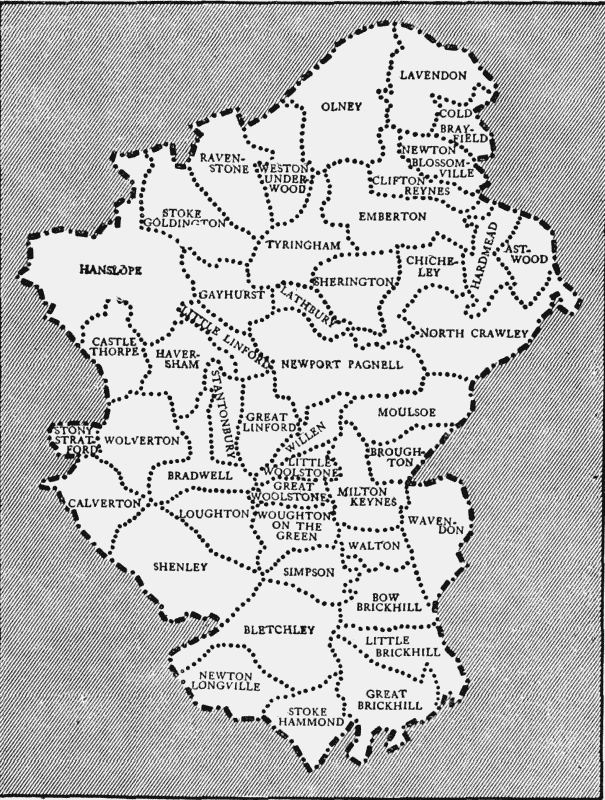A History of the County of Buckingham: Volume 4. Originally published by Victoria County History, London, 1927.
This free content was digitised by double rekeying. All rights reserved.
'Newport hundred: Introduction', in A History of the County of Buckingham: Volume 4, ed. William Page (London, 1927), British History Online https://prod.british-history.ac.uk/vch/bucks/vol4/pp268-269 [accessed 26 April 2025].
'Newport hundred: Introduction', in A History of the County of Buckingham: Volume 4. Edited by William Page (London, 1927), British History Online, accessed April 26, 2025, https://prod.british-history.ac.uk/vch/bucks/vol4/pp268-269.
"Newport hundred: Introduction". A History of the County of Buckingham: Volume 4. Ed. William Page (London, 1927), British History Online. Web. 26 April 2025. https://prod.british-history.ac.uk/vch/bucks/vol4/pp268-269.
THE HUNDRED OF NEWPORT
Containing The Parishes Of Astwood; Bletchely with Fenny Stratford and Water Eaton; Bradwell; Bow Brickhill; Great Brickhill; Little Brickhill; Broughton; Calverton; Chicheley; Clifton Reynes; Cold Brayfield; North Crawley; Emberton; Gayhurst; Hanslope with Castle Thrope Gayhurst; Hanslope with Caste Thrope; Hardmead; Lathbury; Lavendon; Great Linford; Little Linford; Loughton; Milton Keynes; Moulsoe; Newport Pangell; Newton Blossomville; Newton Longville; Olney with Warrington; Ravenstone; Shenley (fn. 1); Sherintgton; Simpson; Stantonbury; Stoke Goldington; Stoke Hammond; Stony Stratford; Tyringham with Filgarve; Walton; Wavendon; Weston Under Wood; Willen; Wolverton; Great Woolstone; Little Woolstone; Woughton On The Green
Of the places enumerated above, Astwood, Bletchley, Fenny Stratford, Cold Brayfield, Castle Thorpe, Newton Blossomville, Stony Stratford, Filgrave, Walton, Warrington and Willen are not mentioned in the Domesday Survey, while Caldecote and Tickford in Newport Pagnell have separate entries. (fn. 2) Newport Hundred includes the hundreds of Sigelai, Bonestou (fn. 3) and Moulsoe (fn. 4) which were grouped in the latter part of the 13th century as the three hundreds of Newport. (fn. 5) Sigelai contained Bletchley, Bradwell, Calverton, Great Linford, Loughton, Newport Pagnell, Newton Longville, Shenley (part of), Simpson, Stantonbury, Stoke Hammond, Stony Stratford, Willen, Great and Little Woolstone, Wolverton and Woughton on the Green. In Bonestou Hundred were Cold Brayfield, Castle Thorpe, Gayhurst, Hanslope, Haversham, Lathbury, Lavendon, Little Linford, Olney, Ravenstone, Stoke Goldington, Tyringham with Filgrave, and Weston Underwood; the remaining parishes were in the hundred of Moulsoe. In 1086 Sigelai Hundred was assessed at 148 hides 2¾ virgates (including 7 hides 1¼ virgates in Tyringham, ½ virgate in Hardmead, and 2 hides 3 virgates in Wavendon), Bonestou at 9 hides ¼ virgate, Moulsoe at 111 hides 2½ virgates (including 5 hides in Tickford afterwards found in Sigelai). (fn. 6)
The three royal hundreds of Newport were attached to the honour of Ampthill in the middle 16th century, (fn. 7) and payments were made to the bailiff of this honour, instead of to the sheriff of the county. (fn. 8) In this and the following century they were usually assessed as a group, (fn. 9) but sometimes, as in 1563 (fn. 10) and 1607, (fn. 11) under each hundred separately. These hundreds were leased in 1614 to Sir Francis Fortescue and his sons John and William for their lives in survivorship, (fn. 12) and their rights were claimed by John, then Sir John Fortescue, kt., in 1651. (fn. 13) In 1663 a lease was granted to Thomas Catesby of Hardmead for twenty-one years. (fn. 14) The three Newport hundreds were assigned to Queen Katherine in dower in 1665, (fn. 15) and she leased them in 1682 for thirty-one years to the Earl of Ailesbury. (fn. 16) On the expiration of this term no grant was made until 1736, when a lease for a similar term was made to Thomas fourth Duke of Leeds. (fn. 17) In 1830 George Thomas Wyndham had the hundredal rights, but by 1855, when the "Manor of the Three Hundreds of Newport" was for sale, all privileges appear to have lapsed. (fn. 18)

Index Map to the Hundred of Newport
An increase in the fee-farm rents of the hundreds of Sigelai, Bonestou and Moulsoe, formerly £5 yearly, was taken by the sheriff after the battle of Evesham. (fn. 19) In 1651 these rents, called certainty money, amounted to £23 8s. yearly, the profits of the court and other perquisites yielding an additional £14 14s. 4d. (fn. 20) At this date the court leet and the three weeks court were held at the customary times. (fn. 21) They were usually called at Bunsty, but (the steward being able to adjourn them at will to any place within the hundreds) kept at Newport Pagnell. (fn. 22)